Efficient Electrocatalytic Nitrogen Reduction to Ammonia with Electrospun Hierarchical Carbon Nanofiber/TiO2@CoS Heterostructures
Abstract
1. Introduction
2. Results and Discussion
2.1. Morphology and Structure
2.2. Electrochemical Measurement
2.3. Mechanism Analysis of the Electrocatalytic Reduction of Nitrogen
3. Experimental Section
3.1. Materials
3.2. Preparation of Porous Carbon Nanofiber (CNF) Membrane
3.3. Preparation of CNF/TiO2
3.4. Preparation of CNF/TiO2@CoS
3.5. Material Characterization
3.6. Electrochemical Measurements
3.7. Determination of NH3
3.8. Determination of Faraday Efficiency (FE) and NH3 Yield
3.9. Determination of N2H4
4. Conclusions
Supplementary Materials
Author Contributions
Funding
Institutional Review Board Statement
Informed Consent Statement
Data Availability Statement
Conflicts of Interest
References
- Schlögl, R. Catalytic Synthesis of Ammonia—A “Never-Ending Story”? Angew. Chem. Int. Ed. 2003, 42, 2004–2008. [Google Scholar] [CrossRef] [PubMed]
- Liao, W.; Xie, K.; Liu, L.; Wang, X.; Luo, Y.; Liang, S.; Liu, F.; Jiang, L. Triggering in-plane defect cluster on MoS2 for accelerated dinitrogen electroreduction to ammonia. J. Energy Chem. 2021, 62, 359–366. [Google Scholar] [CrossRef]
- Foster, S.L.; Bakovic, S.I.P.; Duda, R.D.; Maheshwari, S.; Milton, R.D.; Minteer, S.D.; Janik, M.J.; Renner, J.N.; Greenlee, L.F. Catalysts for nitrogen reduction to ammonia. Nat. Catal. 2018, 1, 490–500. [Google Scholar] [CrossRef]
- Kitano, M.; Kanbara, S.; Inoue, Y.; Kuganathan, N.; Sushko, P.V.; Yokoyama, T.; Hara, M.; Hosono, H. Electride support boosts nitrogen dissociation over ruthenium catalyst and shifts the bottleneck in ammonia synthesis. Nat. Commun. 2015, 6, 1–9. [Google Scholar] [CrossRef]
- Tanabe, Y.; Nishibayashi, Y. Developing more sustainable processes for ammonia synthesis. Coord. Chem. Rev. 2013, 257, 2551–2564. [Google Scholar] [CrossRef]
- Van der Ham, C.J.; Koper, M.T.; Hetterscheid, D.G. Challenges in reduction of dinitrogen by proton and electron transfer. Chem. Soc. Rev. 2014, 43, 5183–5191. [Google Scholar] [CrossRef] [PubMed]
- Suryanto, B.H.; Du, H.-L.; Wang, D.; Chen, J.; Simonov, A.N.; MacFarlane, D.R. Challenges and prospects in the catalysis of electroreduction of nitrogen to ammonia. Nat. Catal. 2019, 2, 290–296. [Google Scholar] [CrossRef]
- Li, M.; Huang, H.; Low, J.; Gao, C.; Long, R.; Xiong, Y. Recent progress on electrocatalyst and photocatalyst design for nitrogen reduction. Small Meth. 2019, 3, 1800388. [Google Scholar] [CrossRef]
- Kugimiya, K.; Kozawa, T.; Harada, T.; Naito, M. Mechano-chemical synthesis of ammonia and acetic acid from inorganic materials in water. Green Process. Synth. 2019, 8, 223–229. [Google Scholar] [CrossRef]
- Li, J.; Zheng, G. One-dimensional earth-abundant nanomaterials for water-splitting electrocatalysts. Adv. Sci. 2017, 4, 1600380. [Google Scholar] [CrossRef] [PubMed]
- Zhong, L.; Zhou, H.; Li, R.F.; Cheng, H.; Wang, S.; Chen, B.Y.; Zhuang, Y.Y.; Chen, J.F.; Yuan, A.H. Co/CoOx heterojunctions encapsulated N-doped carbon sheets via a dual-template-guided strategy as efficient electrocatalysts for rechargeable Zn-air battery. J. Colloid Interface Sci. 2021, 599, 46–57. [Google Scholar] [CrossRef]
- Shah, S.A.; Sayyar, R.; Xu, L.; Sun, H.; Khan, I.; Guo, J.Y.; Shen, X.P.; Hussain, S.; Yuan, A.H.; Ullah, H. In-situ synthesis of NiS2 nanoparticles/MoS2 nanosheets hierarchical sphere anchored on reduced graphene oxide for enhanced electrocatalytic hydrogen evolution reaction. J. Colloid Interface Sci. 2022, 624, 150–159. [Google Scholar] [CrossRef] [PubMed]
- Zheng, J.; Lyu, Y.; Qiao, M.; Veder, J.P.; Marco, R.D.; Bradley, J.; Wang, R.; Li, Y.; Huang, A.; Jiang, S.P. Tuning the Electron Localization of Gold Enables the Control of Nitrogen-to-Ammonia Fixation. Angew. Chem. Int. Ed. 2019, 58, 18604–18609. [Google Scholar] [CrossRef] [PubMed]
- Wang, H.; Mao, Q.; Yu, H.; Wang, S.; Xu, Y.; Li, X.; Wang, Z.; Wang, L. Enhanced electrocatalytic performance of mesoporous Au-Rh bimetallic films for ammonia synthesis. Chem. Eng. J. 2021, 418, 129493. [Google Scholar] [CrossRef]
- He, H.; Zhu, Q.-Q.; Yan, Y.; Zhang, H.-W.; Han, Z.-Y.; Sun, H.; Chen, J.; Li, C.-P.; Zhang, Z.; Du, M. Metal–organic framework supported Au nanoparticles with organosilicone coating for high-efficiency electrocatalytic N2 reduction to NH3. Appl. Catal. B Envirn. 2022, 302, 120840. [Google Scholar] [CrossRef]
- Shi, J.L.; Xiang, S.Q.; Su, D.J.; Liu, X.; Zhang, W.; Zhao, L.B. Theoretical Insights on Au-based Bimetallic Alloy Electrocatalysts for Nitrogen Reduction Reaction with High Selectivity and Activity. ChemSusChem. 2021, 14, 4525–4535. [Google Scholar] [CrossRef]
- Cai, W.; Han, Y.; Pan, Y.; Zhang, X.; Xu, J.; Zhang, Y.; Sun, Y.; Li, S.; Lai, J.; Wang, L. The twinned Pd nanocatalyst exhibits sustainable NRR electrocatalytic performance by promoting the desorption of NH3. J. Mater. Chem. A 2021, 9, 13483–13489. [Google Scholar] [CrossRef]
- Chen, H.-j.; Deng, G.-r.; Feng, Z.-s.; Xu, Z.-q.; Yang, M.-y.; Huang, Y.; Peng, Q.; Li, T.; Wang, Y. Enhanced electrocatalytic performance of TiO2 nanoparticles by Pd doping toward ammonia synthesis under ambient conditions. Chem. Commun. 2022, 58, 3214–3217. [Google Scholar] [CrossRef] [PubMed]
- Wang, Y.; Ma, Z.; Liu, K.; Yang, X.; Wang, J.; Wang, X. Rigid anchoring of highly crystallized and uniformly dispersed Pd nanocrystals on carbon fibers for ambient electrocatalytic reduction of nitrogen to ammonia. Dalton Trans. 2021, 50, 6975–6981. [Google Scholar] [CrossRef]
- Lv, J.; Wu, S.; Tian, Z.; Ye, Y.; Liu, J.; Liang, C. Construction of PdO–Pd interfaces assisted by laser irradiation for enhanced electrocatalytic N2 reduction reaction. J. Mater. Chem. A 2019, 7, 12627–12634. [Google Scholar] [CrossRef]
- Zhao, H.; Zhang, D.; Wang, Z.; Han, Y.; Sun, X.; Li, H.; Wu, X.; Pan, Y.; Qin, Y.; Lin, S. High-performance nitrogen electroreduction at low overpotential by introducing Pb to Pd nanosponges. Appl. Catal. B Environ. 2020, 265, 118481. [Google Scholar] [CrossRef]
- Tong, W.; Huang, B.; Wang, P.; Li, L.; Shao, Q.; Huang, X. Crystal-phase-engineered PdCu electrocatalyst for enhanced ammonia synthesis. Angew. Chem. Int. Ed. 2020, 132, 2671–2675. [Google Scholar] [CrossRef]
- Deng, Y.; Xiao, Z.; Wang, Z.; Lai, J.; Liu, X.; Zhang, D.; Han, Y.; Li, S.; Sun, W.; Wang, L. The rational adjusting of proton-feeding by Pt-doped FeP/C hollow nanorod for promoting nitrogen reduction kinetics. Appl. Catal. B Environ. 2021, 291, 120047. [Google Scholar] [CrossRef]
- Xiong, W.; Zhou, M.; Li, H.; Ding, Z.; Zhang, D.; Lv, Y. Electrocatalytic ammonia synthesis catalyzed by mesoporous nickel oxide nanosheets loaded with Pt nanoparticles. Chin. J. Catal. 2022, 43, 1371–1378. [Google Scholar] [CrossRef]
- Liu, A.; Gao, M.; Gao, Y.; Ren, X.; Yang, Y.; Yang, Q.; Li, Y.; Gao, L.; Liang, X.; Ma, T. DFT study of Ru/graphene as high-performance electrocatalyst for NRR. Inorg. Chem. Commun. 2020, 120, 108169. [Google Scholar] [CrossRef]
- Cheng, S.; Gao, Y.-J.; Yan, Y.-L.; Gao, X.; Zhang, S.-H.; Zhuang, G.-L.; Deng, S.-W.; Wei, Z.-Z.; Zhong, X.; Wang, J.-G. Oxygen vacancy enhancing mechanism of nitrogen reduction reaction property in Ru/TiO2. J. Energy Chem. 2019, 39, 144–151. [Google Scholar] [CrossRef]
- Tayyebi, E.; Abghoui, Y.; Skulason, E. Elucidating the mechanism of electrochemical N2 reduction at the Ru (0001) electrode. ACS Catal. 2019, 9, 11137–11145. [Google Scholar] [CrossRef]
- Liu, A.; Gao, M.; Ren, X.; Meng, F.; Yang, Y.; Yang, Q.; Guan, W.; Gao, L.; Liang, X.; Ma, T. A two-dimensional Ru@MXene catalyst for highly selective ambient electrocatalytic nitrogen reduction. Nanoscale 2020, 12, 10933–10938. [Google Scholar] [CrossRef]
- Qiu, W.; Xie, X.-Y.; Qiu, J.; Fang, W.-H.; Liang, R.; Ren, X.; Ji, X.; Cui, G.; Asiri, A.M.; Cui, G. High-performance artificial nitrogen fixation at ambient conditions using a metal-free electrocatalyst. Nat. Commun. 2018, 9, 1–8. [Google Scholar] [CrossRef] [PubMed]
- Liu, Y.; Zhu, X.; Zhang, Q.; Tang, T.; Zhang, Y.; Gu, L.; Li, Y.; Bao, J.; Dai, Z.; Hu, J.-S. Engineering Mo/Mo2C/MoC hetero-interfaces for enhanced electrocatalytic nitrogen reduction. J. Mater. Chem. A 2020, 8, 8920–8926. [Google Scholar] [CrossRef]
- Lu, X.; Wang, Y.; Huang, J.; Han, N.; Li, H.; Yang, Z.; Peng, Y.; Zhang, X.; Xu, C. Boosting the electrochemical nitrogen reduction by rhenium-doping modulated TiO2 nanofibers. Chem. Eng. J. 2022, 434, 134648. [Google Scholar] [CrossRef]
- Lu, F.; Wang, J.; Chang, Z.; Zeng, J. Uniform deposition of Ag nanoparticles on ZnO nanorod arrays grown on polyimide/Ag nanofibers by electrospinning, hydrothermal, and photoreduction processes. Mater. Des. 2019, 181, 108069. [Google Scholar] [CrossRef]
- Lu, F.; Wang, J.; Sun, X.; Chang, Z. 3D hierarchical carbon nanofibers/TiO2@MoS2 cor-shell heterostructures by electrospinning, hydrothermal and in-situ growth for flexible electrode materials. Mater. Des. 2020, 189, 108503. [Google Scholar] [CrossRef]
- Park, H.; Kim, S.; Kim, T.; Kim, Y.; Joo, S.W.; Kang, M. CoS@TiO2 S-scheme heterojunction photocatalyst for hydrogen production from photoinduced water splitting. J. Clean. Prod. 2021, 319, 128819. [Google Scholar] [CrossRef]
- Ke, Q.; Zheng, M.; Liu, H.; Guan, C.; Mao, L.; Wang, J. 3D TiO2@Ni(OH)2 core-shell arrays with tunable nanostructure for hybrid supercapacitor application. Sci. Rep. 2015, 5, 1–11. [Google Scholar] [CrossRef] [PubMed]
- Liu, Y.T.; Chen, X.; Yu, J.; Ding, B. Carbon-nanoplated CoS@TiO2 nanofibrous membrane: An interface-engineered heterojunction for high-efficiency electrocatalytic nitrogen reduction. Angew. Chem. 2019, 131, 19079–19083. [Google Scholar] [CrossRef]
- Yuan, Y.; Lv, H.; Xu, Q.; Liu, H.; Wang, Y. A few-layered MoS2 nanosheets/nitrogen-doped graphene 3D aerogel as a high performance and long-term stability supercapacitor electrode. Nanoscale 2019, 11, 4318–4327. [Google Scholar] [CrossRef] [PubMed]
- Pan, L.; Zhu, X.D.; Xie, X.M.; Liu, Y.T. Smart Hybridization of TiO2 Nanorods and Fe3O4 Nanoparticles with Pristine Graphene Nanosheets: Hierarchically Nanoengineered Ternary Heterostructures for High-Rate Lithium Storage. Adv. Funct. Mater. 2015, 25, 3341–3350. [Google Scholar] [CrossRef]
- Zuniga, L.; Agubra, V.; Flores, D.; Campos, H.; Villareal, J.; Alcoutlabi, M. Multichannel hollow structure for improved electrochemical performance of TiO2/Carbon composite nanofibers as anodes for lithium ion batteries. J. Alloys Compd. 2016, 686, 733–743. [Google Scholar] [CrossRef]
- Gao, H.; Zhou, T.; Zheng, Y.; Zhang, Q.; Liu, Y.; Chen, J.; Liu, H.; Guo, Z. CoS quantum dot nanoclusters for high-energy potassium-ion batteries. Adv. Funct. Mater. 2017, 27, 1702634. [Google Scholar] [CrossRef]
- Liu, H.; Wei, L.; Liu, F.; Pei, Z.; Shi, J.; Wang, Z.J.; He, D.H.; Chen, Y. Homogeneous, heterogeneous, and biological catalysts for electrochemical N2 reduction toward NH3 under ambient conditions. ACS Catal. 2019, 9, 5245–5267. [Google Scholar] [CrossRef]
- Cheng, H.; Ding, L.X.; Chen, G.F.; Zhang, L.; Xue, J.; Wang, H. Nitrogen reduction reaction: Molybdenum carbide nanodots enable efficient electrocatalytic nitrogen fixation under ambient conditions. Adv. Mater. 2018, 30, 1870350. [Google Scholar] [CrossRef]
- Yuan, L.P.; Wu, Z.Y.; Jiang, W.J.; Tang, T.; Niu, S.A.; Hu, J.S. Phosphorus-doping activates carbon nanotubes for efficient electroreduction of nitrogen to ammonia. Nano Res. 2020, 13, 1376–1382. [Google Scholar] [CrossRef]
- Du, Z.W.; Cheng, X.J.; Huang, Q.L.; Chen, M.X.; Xiao, C.F. Electrospinning organic solvent resistant preoxidized poly(acrylonitrile) nanofiber membrane and its properties. Chin. J. Chem. Eng. 2023, 53, 289–299. [Google Scholar] [CrossRef]
- Zhu, J.S.; Gao, T. Determination of hydrazine in water by spectrophotometry. Petrochem. Indus. Tech. 2015, 22, 110–111. (In Chinese) [Google Scholar]
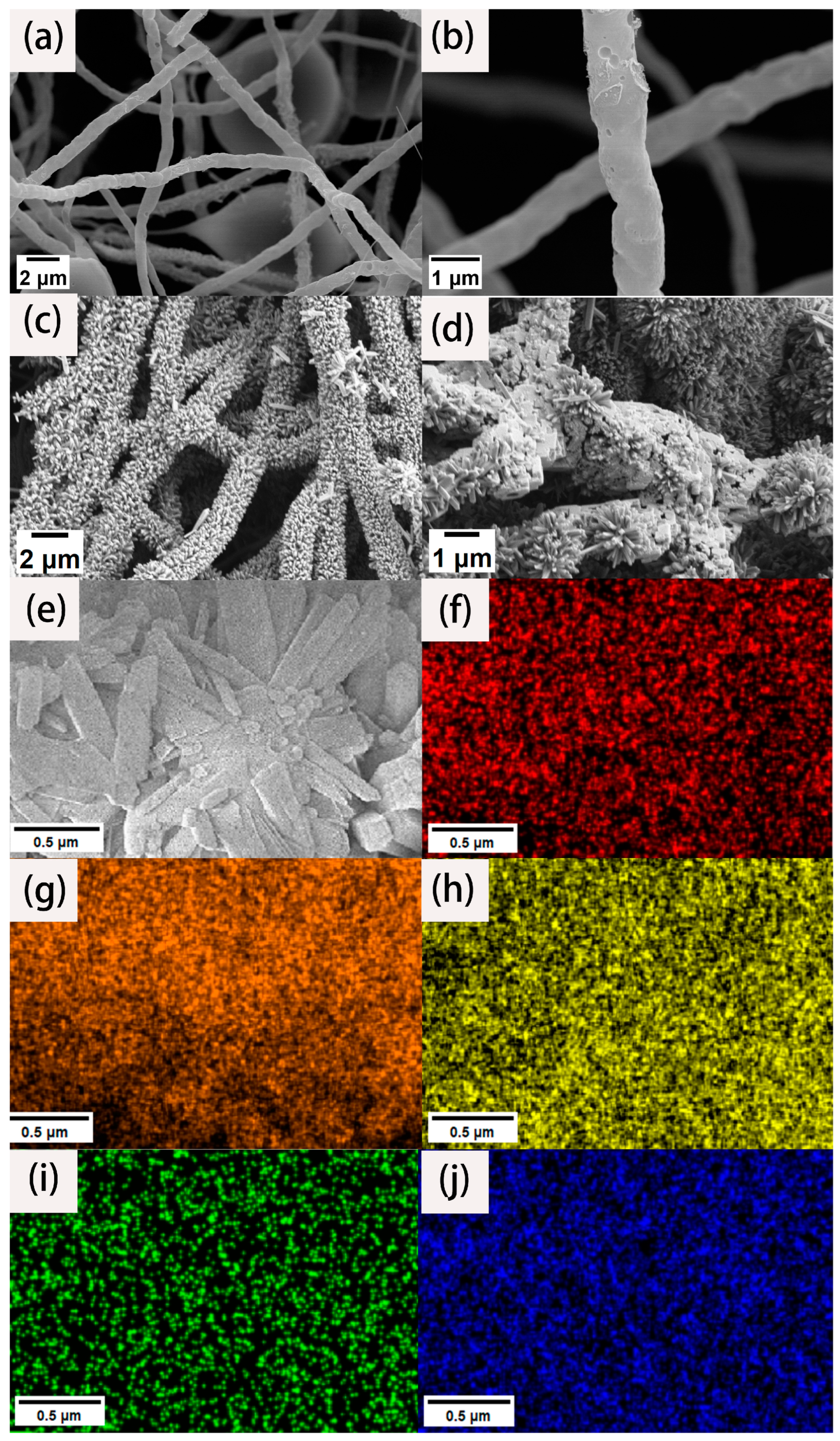

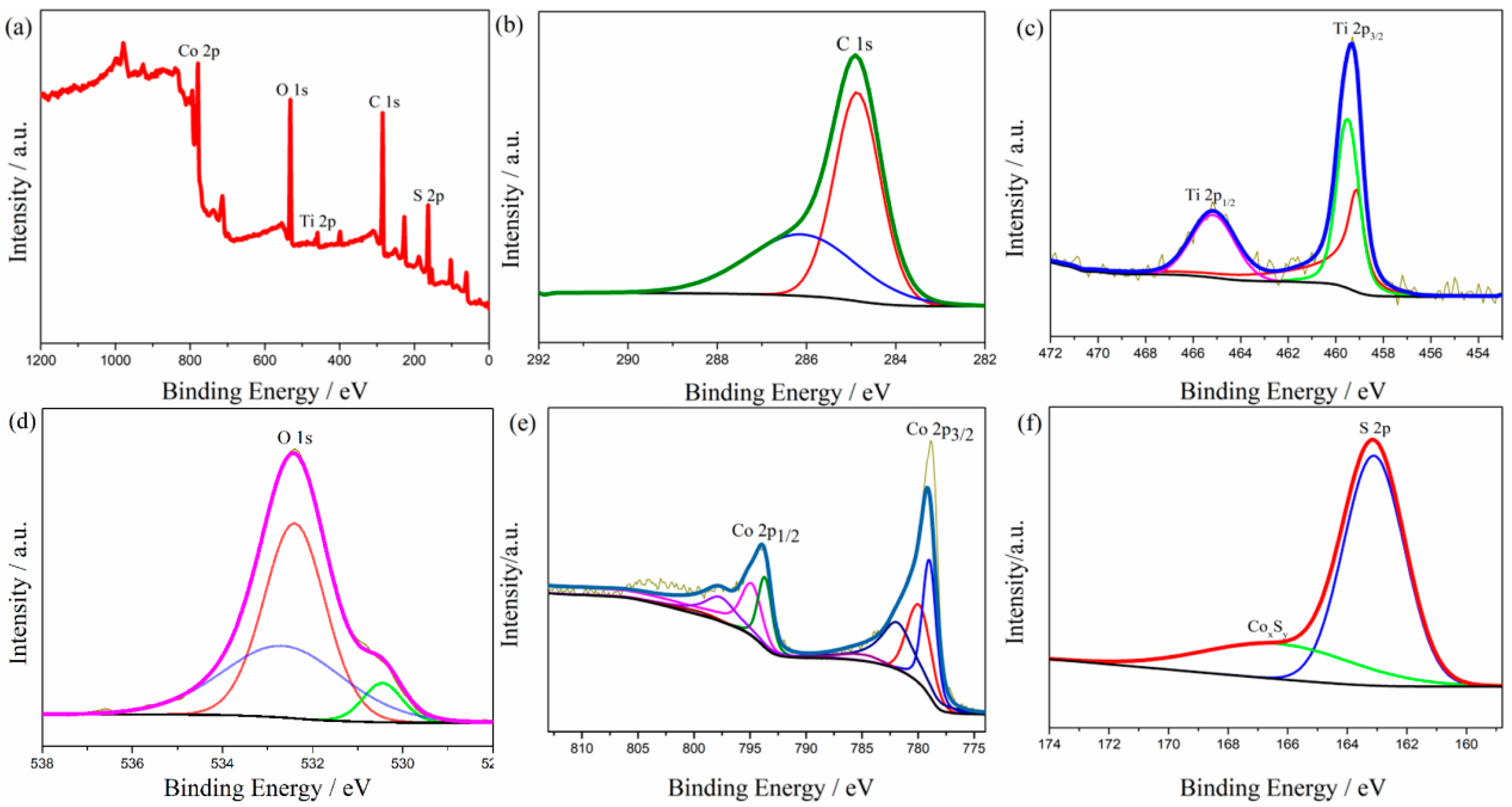
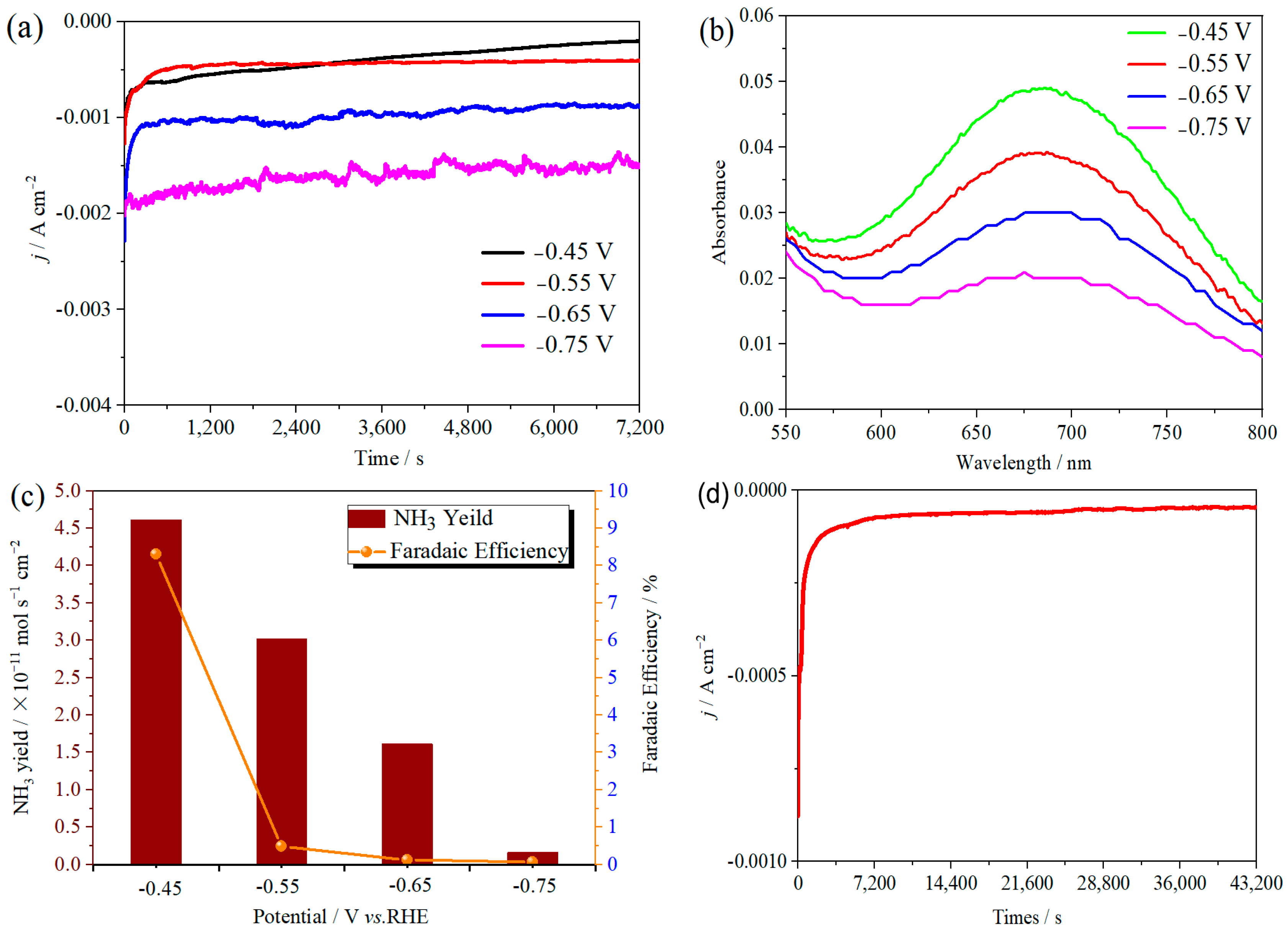
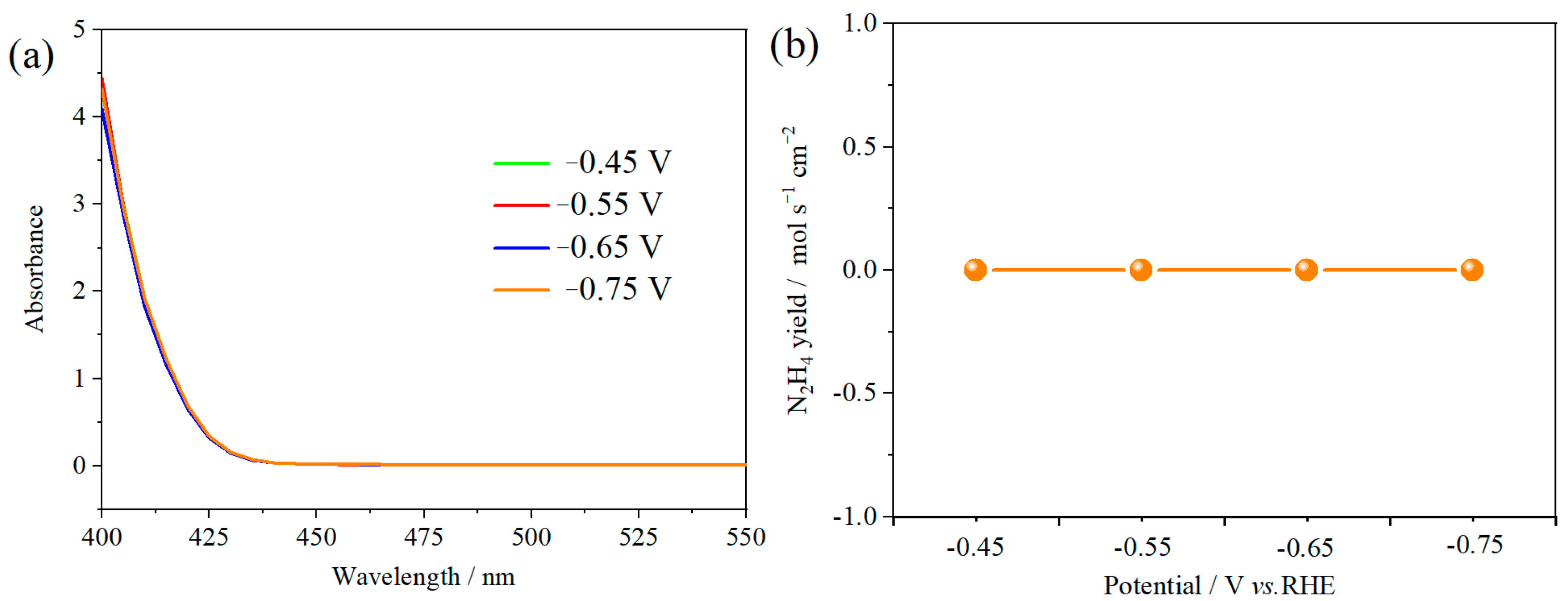
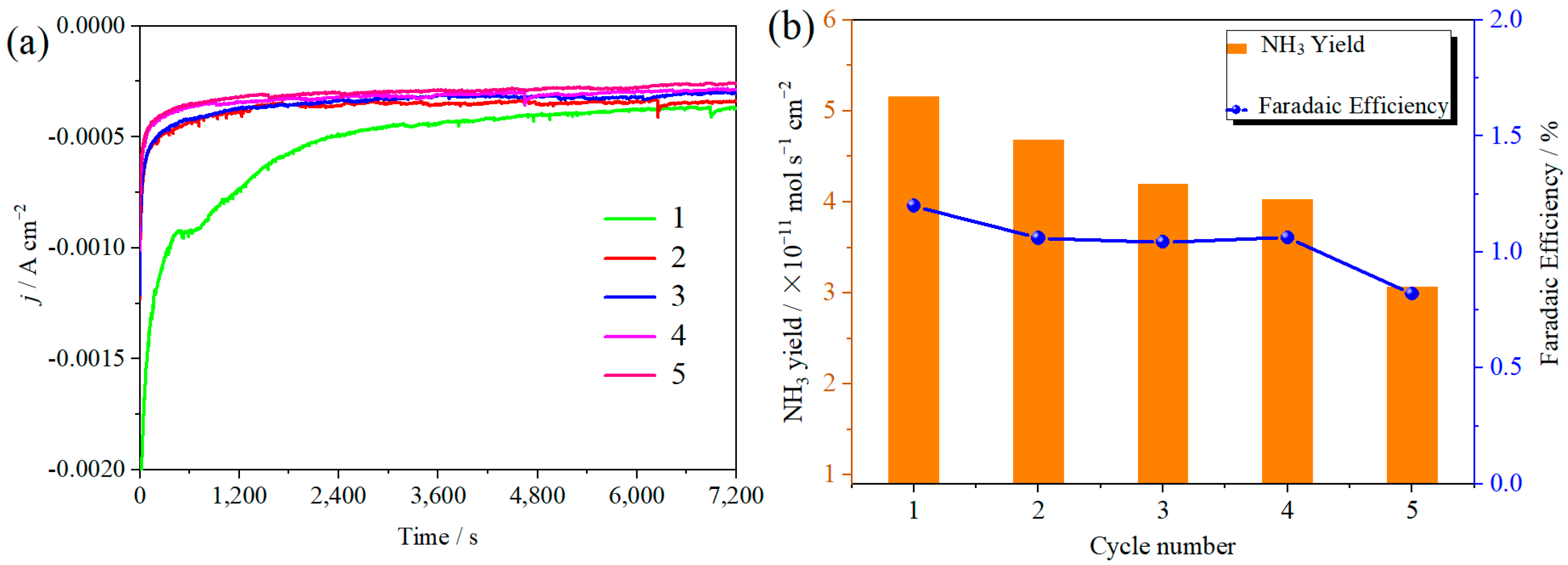
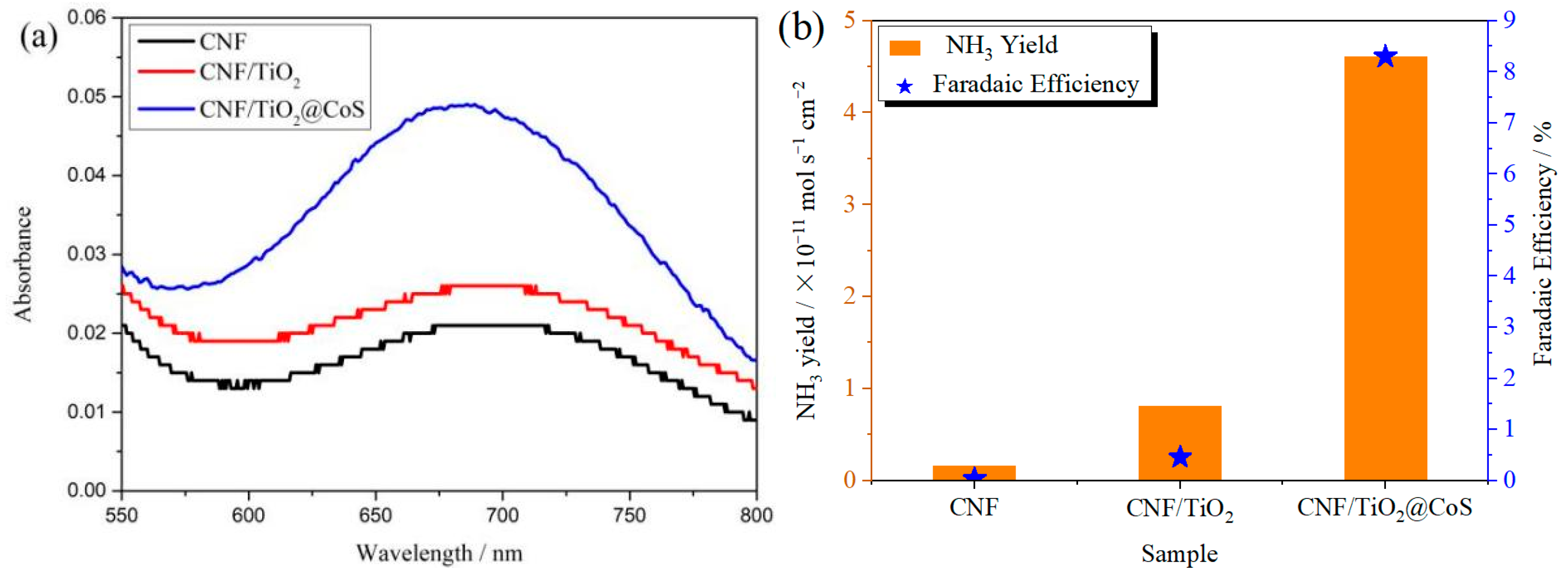
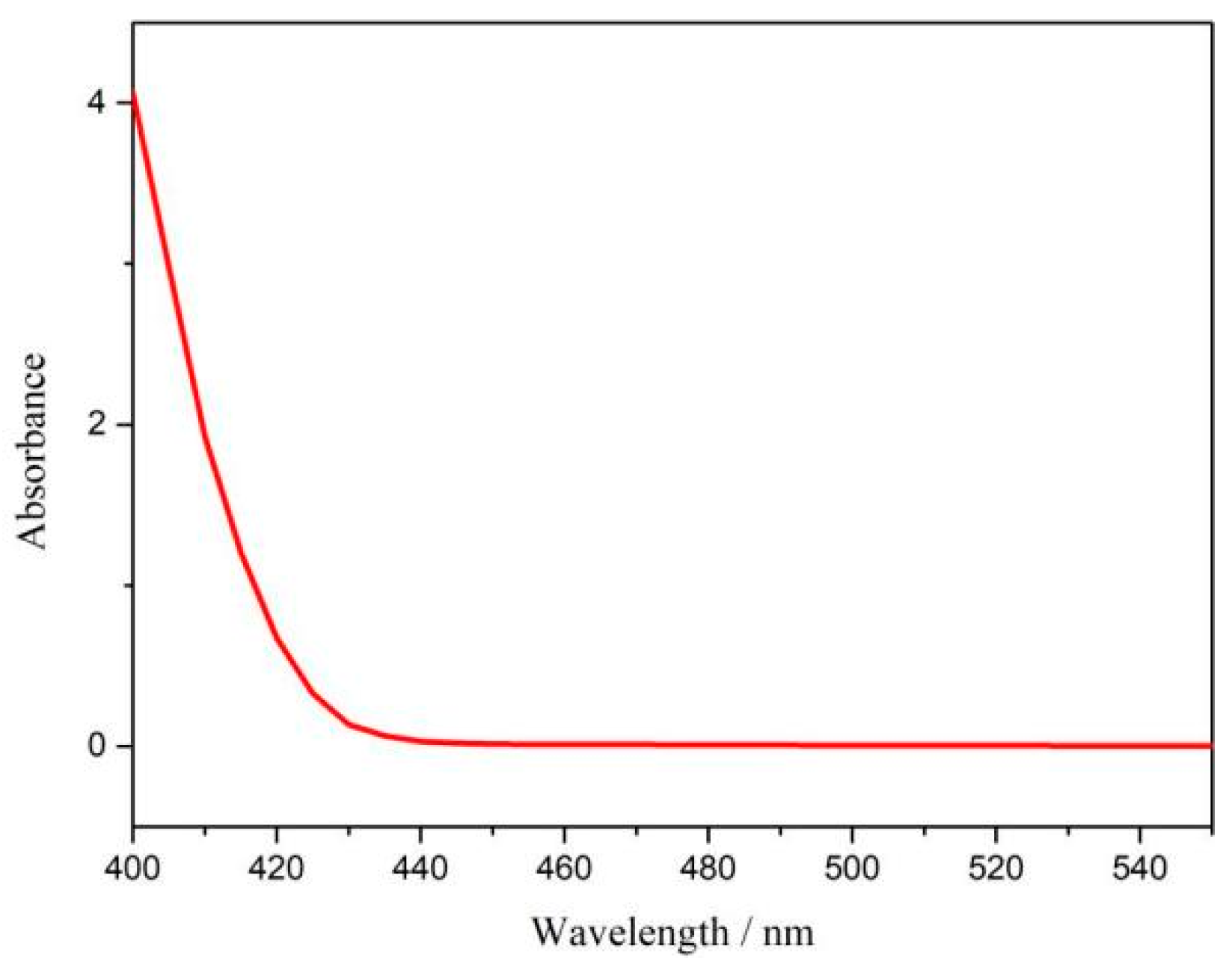
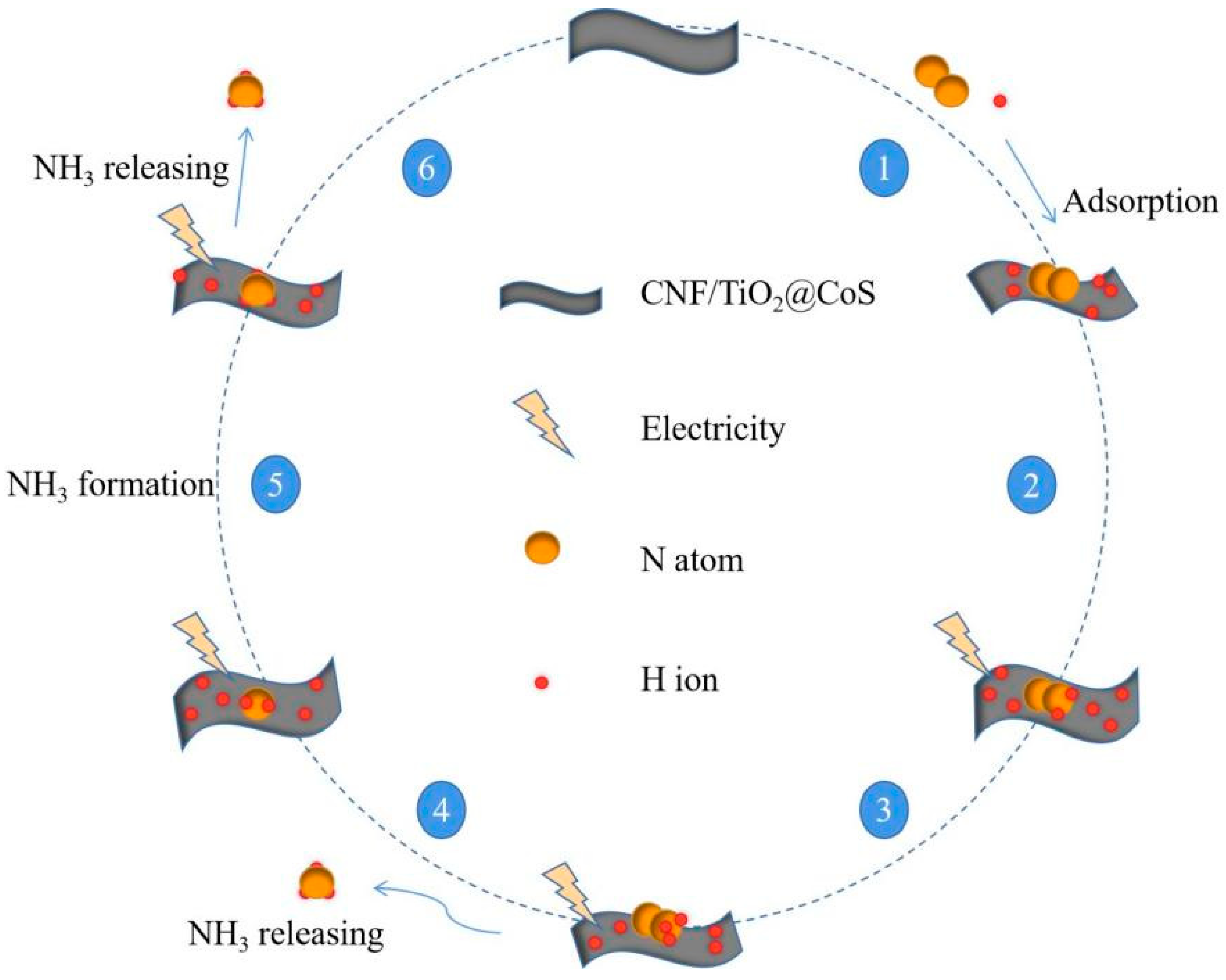
Disclaimer/Publisher’s Note: The statements, opinions and data contained in all publications are solely those of the individual author(s) and contributor(s) and not of MDPI and/or the editor(s). MDPI and/or the editor(s) disclaim responsibility for any injury to people or property resulting from any ideas, methods, instructions or products referred to in the content. |
© 2024 by the authors. Licensee MDPI, Basel, Switzerland. This article is an open access article distributed under the terms and conditions of the Creative Commons Attribution (CC BY) license (https://creativecommons.org/licenses/by/4.0/).
Share and Cite
Chang, Z.; Jia, F.; Ji, X.; Li, Q.; Cui, J.; Liao, Z.; Sun, X. Efficient Electrocatalytic Nitrogen Reduction to Ammonia with Electrospun Hierarchical Carbon Nanofiber/TiO2@CoS Heterostructures. Molecules 2024, 29, 6025. https://doi.org/10.3390/molecules29246025
Chang Z, Jia F, Ji X, Li Q, Cui J, Liao Z, Sun X. Efficient Electrocatalytic Nitrogen Reduction to Ammonia with Electrospun Hierarchical Carbon Nanofiber/TiO2@CoS Heterostructures. Molecules. 2024; 29(24):6025. https://doi.org/10.3390/molecules29246025
Chicago/Turabian StyleChang, Zhenjun, Fuxing Jia, Xingyu Ji, Qian Li, Jingren Cui, Zhengzheng Liao, and Xiaoling Sun. 2024. "Efficient Electrocatalytic Nitrogen Reduction to Ammonia with Electrospun Hierarchical Carbon Nanofiber/TiO2@CoS Heterostructures" Molecules 29, no. 24: 6025. https://doi.org/10.3390/molecules29246025
APA StyleChang, Z., Jia, F., Ji, X., Li, Q., Cui, J., Liao, Z., & Sun, X. (2024). Efficient Electrocatalytic Nitrogen Reduction to Ammonia with Electrospun Hierarchical Carbon Nanofiber/TiO2@CoS Heterostructures. Molecules, 29(24), 6025. https://doi.org/10.3390/molecules29246025



